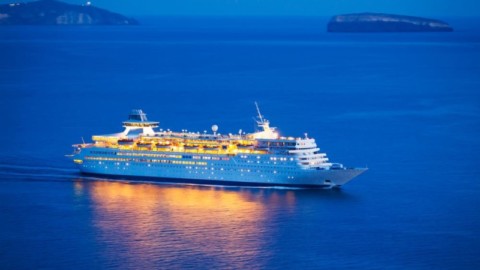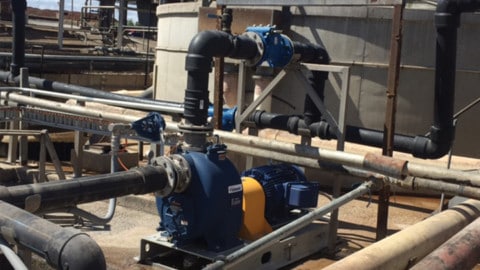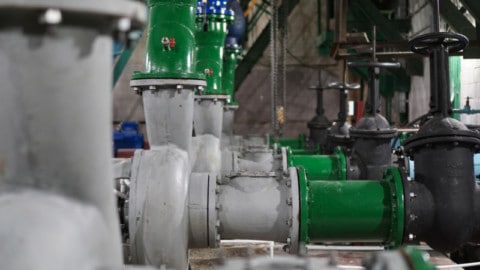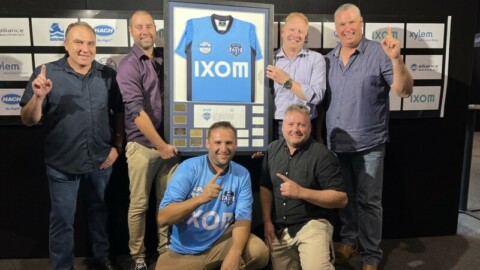Reef HQ Aquarium in Townsville is the world’s largest living coral reef aquarium and was originally designed to make experiencing the wonders of the Great Barrier Reef accessible and affordable, while also spreading the Reef conservation message and gaining public support for the protection of the ‘real thing’. However, since its opening in 1987, the aggressive tropical environment of the region and the stress of holding in excess of four million litres of saltwater have impacted the facility, resulting in the need for a major refurbishment and upgrade of aging infrastructure to ensure optimal operation. Pump Industry spoke to Sasha Thyer an expert at Reef HQ Aquarium about the redevelopment and upgrades, including those undertaken to the plant room, fire systems, life support systems, and hydraulic systems.
Since the transformation of Reef HQ Aquarium began in 2019, the Australian Government has committed $80.1 million to develop a global centre of excellence in tropical coral reef education. The works are occurring in stages with early works undertaken to improve aquatic life support systems.
Early works program
The early works program focused on a number of projects that primarily aimed to resolve critical safety issues, as well as other works required to relocate and upgrade connected systems at the same time.
“The early works program was necessary to address the most urgent rectification requirements of aging critical systems at Reef HQ Aquarium affecting safety, function and animal life support systems,” Ms Thyer said.
“Fundamental building services required replacing or upgrading, including the building’s electrical network, elements of the Heating, Ventilation, Air Conditioning, Chilling and Refrigeration (HVAC&R), building structural elements, and animal life support systems.
“The Aquarium is 35 years old, and located in a hot, humid seawater environment in North Queensland, which requires highly durable equipment and systems. It is also unique in its function – being home to the largest living coral reef aquarium, with a total of four million litres of seawater being integrated into the building structures. The Coral Reef Exhibit (CRE) requires 24/7 uninterrupted power and stability for key water quality parameters, thus system failures can become critical quite quickly.”
Careful and highly detailed programming and contingency planning began more than 18 months before the site was handed over to a Principal Contractor to manage the remaining scope of works, including likely latent issues that may be exposed during the construction phase.
“Space in the building is limited, so efficient use of space was also important. Due to the severe weather season in North Queensland, careful scheduling had to occur and there were many dependencies relying upon government permissions and other permitting authorities (such as the electrical network provider),” Ms Thyer said.
“A core limitation and complexity for the project was that continuity of basic building services such as power, chilling systems and pumping systems had to be maintained to ensure animal life support systems were not interrupted for more than two hours. Backup systems were required to guarantee the two hour window was not exceeded, and major construction activities had to be avoided where possible during the severe weather season.”
Upgrading the plant rooms
New plant rooms were built on level one directly above an exiting substation to house electrical and mechanical services, including the thermal energy storage unit, life support systems, electrical battery storage and the main switchboard.
Some of these services required relocation due to works and changes in their existing locations, and others were new to Reef HQ’s operating systems, but were implemented to improve energy efficiency. One of the main projects was the replacement of the Aquarium’s main electrical switchboard (MSB), originally installed in 1986, and associated distribution switchboards.
As the existing plant room had been subject to subsidence and was potentially exposed to flooding, it was relocated from the ground floor to the first floor. Due to the requirement for no power interruption, and to allow a smooth changeover and minimal power interruptions, the existing MSB had to remain in place until the new MSB was operational. At the same time, an old substation containing 35-year-old transformers owned by Ergon Energy had to be replaced and relocated to a padmount transformer in a different location.
Ms Thyer said that this had knock-on effects, requiring other major systems to be relocated. “The coral reef exhibit heater and animal life support systems had to be relocated to make way for the padmount transformer. The solution to all these challenges was to construct a new plant room directly above the substation to contain the new MSB, heater, thermal storage and life support systems,” Ms Thyer said.
“This occurred whilst all the existing systems stayed operational. New foundation piles had to be installed to accommodate the new structure, and other systems required protection from the construction works. Meticulous planning, scheduling, risk management and communication was required to ensure all scenarios were planned for and all phases ran smoothly.”
Improving energy efficiency in the plant room
A fundamental corporate principle for the Great Barrier Reef Marine Park Authority is sustainability and energy efficiency in the delivery of its services. The upgrades provided an opportunity for sustainability improvements to be made, such as the use of high efficiency pumps and locating life support systems to minimise pumping power.
“Major retrofit actions rarely occur in the life of most buildings so it is important to seize the opportunity for improvements across all levels of service. Every project involved greater efficiency through a range of mechanisms including guiding principles of the circular economy,” Ms Thyer said.
“Materials and equipment were reused where possible or recycled. Design of every system was reviewed, even if the requirements had not changed. The integration of system efficiencies was considered overall, reviewing elements such as cable and pipe distances, location of supporting equipment and structures, maintenance requirements, system lifecycle costs and energy use, and smart building management systems.
“High efficiency pumps were chosen, and life support systems were located in order to minimise pumping power and requirements. The new pump room services included the main electrical system (MSB), solar power inverters, and associated electrical battery storage system, communications equipment, a new thermal storage system (ice), animal life support systems and heat exchangers.”
The relocation of the Predator Exhibit life support system resulted in no additional energy use for filtration pumping, but has provided greater efficiency for cooling/heating (heat exchanger) due to its closer proximity to the Aquarium exhibit. Ms Thyer said the relocation of the Coral Reef Exhibit life support system resulted in significantly greater efficiencies, as the design was changed to reduce pipe distances (horizontally and vertically), and pumping requirements were reduced by utilising more circulation pumps inside the tank and less sand filtration, which was previously used excessively.
Furthermore, recycled glass was used in the sand filters to improve flow and reduce compacting. The wave machine, which supports the coral reef exhibit, was also refurbished for longevity and greater efficiency. One of the most important improvements to efficiency was to optimise the location of equipment to minimise friction losses through pipework and pumping heights.
“The Coral Reef Exhibit foam fractionator and ozone system were also redesigned to minimise pumping head height, and we were able to take advantage of low-head pico-hydro turbines to recover energy returning to the main exhibit tank. The pico-hydro generators (which are a turbine-style generator) are capable of recovering 10,000kWh per year, which is fed straight back to the building’s electric network via inverters,” Ms Thyer said.
“We were also able to use rejected heat from the chilling system (the new thermal storage system) to heat the Coral Reef Exhibit in winter – this created significant efficiency for energy and space.
“New system controls on the Coral Reef Exhibit wave machine allowed more control to finely tune the system for greatest efficiency, to find the optimum wave height and frequency.”
A new thermal energy storage system
The Aquarium was already utilising a 20kL chilled water thermal storage system to minimise stop/start of the HVAC main chillers and shave the facility’s peak power load.
While this system was working well – and was relocated to the new plant room above the old substation – the 216kW solar power system was generating a surplus during the highest solar radiation periods. As the electrical network provider did not require power export back to the grid, the surplus power was being wasted.
A solution to this issue came with an invitation to partner with Glaciem Technologies under the Advancing Renewable Program co-funded by the Australian Renewable Energy Agency (ARENA).
“Our commitment involved working through complexities in a real-world setting to refine the technology. The project included the installation of a new thermal storage system using phase change materials (ice), a carbon neutral refrigerant (CO2) and 50kW of additional solar panels for the existing solar power system,” Ms Thyer said.
“As the existing Coral Reef Exhibit filtration system had to be moved to make way for the new padmount transformer, on request by the Reef Authority, the design of the new thermal storage system also incorporated energy recovery by utilising the system pumps to redirect waste heat to the Coral Reef Exhibit in winter.
“This may seem counterintuitive, however the Aquarium building requires space cooling for all but two to three weeks of the year, whereas heating is required for the Coral Reef Exhibit for three to four months.”
Energy efficiency results
The Aquarium is still collecting data and tweaking and refining the systems as there has been a drop in power requirements due to COVID-19, and some systems have been decommissioned as Reef HQ was closed to enable major works to occur.
While this has made it difficult to precisely determine the overall savings, Ms Thyer said significant savings are evident through the design and relocation of the animal life support pumping systems.
Furthermore, 50kW of new solar power was added to the solar system, bringing it to a total of 260kW, and the new thermal storage and heating system, which uses heat generated by the chilling system to heat the Coral Reef Exhibit in winter, has eliminated the need for a dedicated heater (48kWr heating capacity). The pico-hydro generators will recover 10,000kWh per year from the Coral Reef Exhibit life support system, which represents ten percent of the pumping power required for the system.
Fire system upgrades
Both wet and dry fire systems were upgraded to meet current standards, and were triggered by works associated with the relocation of the main switchboard. The wet fire hydrant system included a connection manifold to the Townsville City Council mains water system and involved the installation of a fire hydrant booster pump.
Ms Thyer said the fire hydrant booster pump project was a huge challenge, particularly when it came to the space and correct location for the fire hydrant booster pump and space for the reticulation pipework.
“To bring the building’s emergency systems up to the modern standards, the booster pump and associated pipe network were required. Reticulating the large pipes around an existing building that contains four million litres central to its main structure was an enormous design challenge,” Ms Thyer said.
“Locating the fire booster pump to comply with proximity requirements adjacent to the new padmount transformer and other building structures seemed like mission impossible and required an underground stormwater drain to be relocated to accommodate it.
“A major setback for this project was that the final test of the mains water pressures resulted in inadequate mains pressures. This was due to the mains water system pressures changing during the construction period. Resolution of this issue was pushed forward into the major works.”

Plant room for sand filters and thermal energy.
Upgrading mechanical and hydraulic services
A number of mechanical services required replacement as they had come to the end of their life, including other upgrades to the wave machine’s air delivery system, motors and pneumatic equipment, and new blower motors. Ms Thyer said the wave machine was originally installed by Boes Technology in 1986 and was functioning remarkably well, delivering a wave every eleven seconds, 24 hours a day, 365 days a year for 35 years.
“It is a beautifully simple, effective and energy efficient system. It delivers a huge volume of laminar flow through the entire exhibit, and this is supplemented by turbulent flow which is directed by low voltage, carbon fibre circulation pumps inside the exhibit,” Ms Thyer said.
“Laminar flow is important to the coral colonies as it pushes water through the coral heads, and this allows gaseous exchange and the removal of waste. It also allows waste to be blown out of the rocky substrate and keeps all areas oxygenated.
“The original blower motors were 75kW which could deliver a massive wave, much larger than required. The blower motors were at the end of their life, so they were replaced with a 40kW high efficiency motor, with a new variable speed drive and upgraded control system.
“In 2016, the other parts of the system (the compressors, receiver, air dryer and ducting) were replaced and thus in 2020-21 were still in good working condition. The system design was found to be still relevant and efficient, so only modernisation of the control system was required.
“Commonwealth procurement processes were followed for this work which was relatively low value and, in this case, involved quotes from numerous local suppliers and installation by a local technician.”
Some hydraulic services were modified, replaced or repaired as part of the retrofit actions in other works, including an overhaul of the creekwater intake system to mitigate the risks of failure. Some preliminary works were required to address failed valves, pipework and pump seals, and the larger upgrade will include a complete review of the creekwater intake system, to mitigate risks and maximise efficiencies.

Three of the four new protein skimmers.
Upgrading life support systems
In May 2020, the Aquarium received $2.6 million in funding from the COVID-19 Relief and Recovery Fund to assist Great Barrier Reef Tourism and the North Queensland regional economy. This investment was used to upgrade the crucial animal life support systems that were at the end of their life, and some systems that had already partly failed or become inadequate to meet modern standards.
One system had to be relocated to enable some building structural repairs. The animal life support systems maintain critical parameters for inhabitants of the Aquarium to thrive, such as oxygen, low nutrients, low pathogen levels, optimum salinity, temperature, pH and calcium levels.
These systems also enable the intake of new seawater from the adjacent Ross Creek. During the severe weather season, the system can remove freshwater via reverse osmosis to maintain salinity within critical parameters. Ms Thyer said meticulous planning was fundamental to the success of the early works as scheduling had to take into account the severe weather season, long lead times on equipment, government permissions, and crucially, the requirement to maintain the operation of most of the systems throughout the construction phase.
“There were many interfaces between projects and where building structural work was involved, latent issues associated with an old building were likely. Contingency planning was very important with room in the schedule and budget to accommodate any issues that may arise,” Ms Thyer said.
“The projects involved a lot of highly specialised equipment, so the right expertise was critical to smooth implementation and also good communication between the Reef Authority team, Project Manager and the contractor’s Project Manager.”
Upgrading the reverse osmosis machines
The reverse osmosis (RO) system uses very high pressure pumps to push seawater into a membrane where the freshwater can travel through (the ‘permeate’) and the concentrated saltwater (the ‘concentrate’) is left behind. In other settings, RO is usually used to create drinking water from seawater or contaminated water, but at the Aquarium it is used to remove rainwater from the large open topped aquariums to maintain the correct amount of saltiness (salinity). It can also correct the salinity of new seawater water taken from the adjacent the Ross Creek.
The reef tank inhabitants are very sensitive to changes and the salinity needs to be maintained at 33-35ppt. During severe weather seasons, huge rainfall can occur – in 2019 the region copped 381mm rain in 24hrs and 277mm in just three hours– and the salinity can only be adjusted by RO or the addition of salt. Ms Thyer said RO is preferred as it can be activated automatically when staff are not on-site and does not involve manual handling of salt.

Old predator tank sand filter.
The Aquarium’s old RO system was at the end of its life and had failed completely during the 2019 wet season which saw a once in 100-year flooding event. This meant that 40 tonnes of artificial salt had to be added by hand (20kg bag at a time) by staff over a four day period.
The old system could remove 27,000L of freshwater per day while the new system can remove 45,000L per day. Ms Thyer said the new system provides resilience and redundancy in the overall system, mitigates risks associated with flooding, and also helps to manage the variety of events that can occur.
“The new systems are better protected from the elements (some outside systems were moved into the new plant room) and moved out of areas that could possibly be exposed to flooding. The new foam fractionator system includes a degassing reservoir to ensure that no residual ozone can enter the Aquarium tanks,” Ms Thyer said.
The ozone configuration and dosing was improved to allow for optimal removal of waste products, and the systems were made safer for staff to operate and more energy efficient. The energy efficiency improvements mean the emergency power system is able to service more equipment for longer.
“RO systems are specialised, however, there are quite a few options available in the marketplace. In this case, the Aquarium requires a medium sized system (not a domestic sized system and not a municipal water sized system), so the number of options for size and other requirements – such as short lead time and specific technical requirements and local support – narrowed the field,” Ms Thyer said.
“The Commonwealth Government has mandatory procurement processes that must be followed. In this case, a number of suppliers were approached to quote on the new system and the urgency of the project was an element in the procurement method chosen.”

Installing the thermal energy storage unit.



















